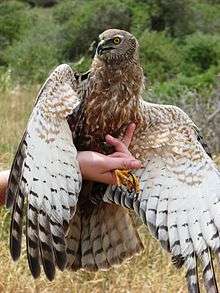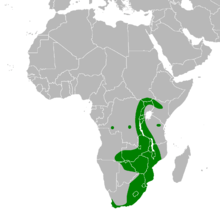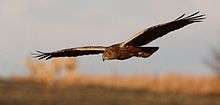African marsh harrier
| African marsh harrier | |
|---|---|
 | |
| Scientific classification | |
| Kingdom: | Animalia |
| Phylum: | Chordata |
| Class: | Aves |
| Order: | Accipitriformes |
| Family: | Accipitridae |
| Genus: | Circus |
| Species: | C. ranivorus |
| Binomial name | |
| Circus ranivorus Daudin, 1800 | |
 | |
The African marsh harrier (Circus ranivorus) is a bird of prey belonging to the harrier genus Circus. It is largely resident in wetland habitats in southern, central and eastern Africa from South Africa north to South Sudan.
Description

The adult is 44 to 49 cm long, with females being about 30% heavier than males (Simmons and Simmons 2000). Adults, (like the male bird right) have yellow eyes, but brown eyes when immature. Both sexes are mostly brown with pale streaking on the head, breast and forewing and rufous on the thighs and belly. Adult males differ from females in that they have a pale grey wash to the dorsal secondaries and primaries. The female's are brown. The juvenile is dark brown and may have a pale breastband and pale markings on the head. The tail and flight feathers have dark barring at all ages, but this is rarely visible in the juvenile birds.
It resembles a small Eurasian marsh harrier but is slimmer and paler brown. Could be mistaken for an immature Montagu's harrier or pallid harrier, species which winter in Africa but the African marsh harrier can be readily distinguished from them by its lack of a white rump.[2]
It is usually silent but the male has a high-pitched, two-note display call, and only the female has the far-carrying pseeew-pseeew food and copulation call during breeding.
Habitat
Generally found in marshes or reedbeds and hunts over open grasslands and cultivation near wetlands.[2] Found from sea level up to 3000 metres, in east Africa it predominantly occurs above 1500 metres.[3]
Distribution
Mainly resident in the moister regions of southern and eastern Africa, from Western Cape northwards through eastern South Africa, Lesotho, Swaziland, eastern Zimbabwe, south and western Mozambique, Malawi,south western Tanzania, western and central Zambia, south eastern Angola into northern Botswana, especially in the Okavango Delta, and north eastern Nambia. Disjunct populations occur in northern Tanzania, another two in the south of Democratic Republic of Congo, another in eastern Democratic Republic of Congo, Rwanda and south eastern Uganda; and the northernmost in north western Kenya, far north Uganda and South Sudan.[2]
Habits and ecology
It has a varied diet which includes small mammals (70% of items[4]) and adult birds, fledglings, lizards, frogs and large insects. Birds up to the size of Red-billed teal and speckled pigeon.[2] A favoured prey in some areas are doves, especially laughing dove. African marsh harriers are not found in areas with less than 300mm annual rainfall as wetlands are sparse in regions with less rainfall, its main prey in southern Africa, the striped mouse Rhabdomys pumilio , is also restricted to this isohyet.[4] It will also feed on larger animals such as flamingoes carrion left by, for example, African fish eagle. Most prey is caught on the ground but birds and insects often caught on the wing.[2]
Unlike many harriers it is monogamous and remains on the breeding territory for most of the year. In the southern Cape birds leave for a few months post-breeding, returning in May–June. The nest is usually built in a reedbed, sometimes well above the water and two to four white eggs are laid from July to November. All eggs start out with a blue wash allowing newly laid eggs to be identified.
The African marsh harrier does not form communal roosts, unlike other harriers and normally roosts solitarily. Leaves the roost earl;y in the morning and then flies slowly over the ground. It hunts in typical harrier fashion, usually less than 10 metres above the ground, over wetlands and adjacent drier ground.[2]
Conservation
African marsh harriers are reported to be common at many wetland sites in both eastern and southern Africa, especially in Uganda, Botswana and Zambia. In South Africa, an estimated 3,000-6,000 pairs remain, but some population are declining there and is regarded as.[4] Outside South Africa there are still large areas of suitable habitat, e.g. the Okavango Delta in Botswana and over much of Zambia, and the species is still locally common . The population is preliminarily estimated to number between 10,000-100,000 individuals.[5]
Populations are declining due to drainage and damming of wetland habitats, over-grazing and human disturbance and, possibly, pesticide poisoning.[5]
References
- ↑ BirdLife International (2013). "Circus ranivorus". IUCN Red List of Threatened Species. Version 2013.2. International Union for Conservation of Nature. Retrieved 26 November 2013.
- 1 2 3 4 5 6 Brown, Leslle H..; Urban, Emil K.; Newman, Kenneth (1982). Birds of Africa Volume I. Academic Press. ISBN 0-12-137301-0.
- ↑ Ferguson-Lees, James; Christie, David A. (2001). Raptors of the World. Chrstopher Helm. ISBN 0-7136-8026-1.
- 1 2 3 "African Marsh Harrier" (PDF). Southern African Bird Atlas Project. Retrieved 17 July 2016.
- 1 2 "Circus ranivorus (African Marsh-harrier, African Marsh Harrier, African Marsh-Harrier)". IUCN. Retrieved 17 July 2016.
- BirdLife International (2006) Species factsheet: Circus ranivorus. Downloaded from http://www.birdlife.org on 20/2/2007
- Roger Clarke (1995) The Marsh Harrier, Hamlyn, London.
- Ian Sinclair & Peter Ryan (2003) Birds of Africa south of the Sahara, Struik, Cape Town.
- Simmons R.E. (1997) African Marsh Harrier In: Atlas of Southern African birds Vol 1. Non-passerines. (Eds James Harrison, David Allan, Les Underhill, Marc Herremans, Vincent Parker, Chris Brown) Avian Demography Unit University of Cape Town.
- Simmons R.E. Simmons J.R. (2000). Harriers of the world: their behaviour and ecology. Oxford University Press, UK
- Tarboton W.R. Allan D. (1984) The status and conservation of birds of prey of the Transvaal. Tvl Mus Monographs No. 4. Pretoria South Africa.
External links
- African marsh harrier - Species text in The Atlas of Southern African Birds

